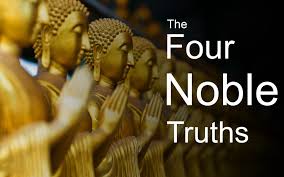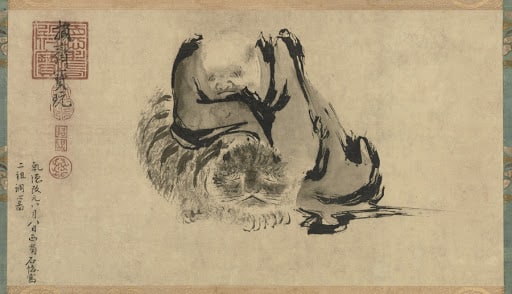The teaching commonly called the “four noble truths” is the most widely known teaching of the historical Buddha, who lived and taught during the 5th century BCE in northern India. The four words that comprise the four truths—Sanskrit duḥkha and Pali dukkha (“pain”), samudaya (“arising”), nirodha (“ending”), and mārga/magga (“path”) or dukkhanirodhagāminī paṭipadā (“way leading to the ending of pain”)—are recorded in Pali and Sanskrit in the different Buddhist canons.
The four noble truths are most readily found in the Pali canon of the Theravada school. The best known is the Dhammacakkappavattana Sutta (Sutta on the turning of the dhamma wheel), but the four noble truths are widely mentioned throughout the Pali canon, as in the Great Discourse on Establishing Mindfulness (Mahāsatipaṭṭhāna Sutta) in the Dīgha-nikāya.
The Four Noble truths are:
1 – Dukha (Suffering)
2 – Trishna/Raga (Origin of suffering – Craving)
3 – Nirvana (Cessation of suffering)
4 – Path that leads to the cessation of suffering (The Noble Eightfold Path)
1 – The Noble Truth of Suffering:
Birth is suffering, aging is suffering, death is suffering. Sorrow, lamentation, pain, sadness and distress are all suffering. Being attached to the unloved is suffering; being separated from the loved is suffering. Not getting what one wants is suffering. In short, the five aggregates of grasping (form, consciousness, perception, feeling/sensation, volition) are suffering.
The Reality of Suffering–dukkha
The Pali word dukkha, in ordinary usage, means ‘suffering’, ‘pain’, ‘sorrow’ or ‘misery’. But in the context of the First Noble Truth, dukkha also means ‘imperfection’, ‘impermanence’, ’emptiness’, ‘insubstantiality’. There are three kinds of suffering:
– Ordinary Suffering–dukkha-dukkha
– Suffering produced by Change–virapinama-dukkha
– Suffering as the Conditioned States–samkara-dukkha
Ordinary Suffering–dukkha-dukkha
There are all kinds of suffering in life: birth, old age, sickness, death, association with unpleasant persons and conditions, separation from beloved ones and pleasant conditions, not getting what we desire, grief, lamentation, distress–all forms of physical and mental suffering.
Suffering produced by Change–virapinama-dukkha
Pleasant and happy feelings or conditions in life are not permanent. Sooner or later they will change. When they change, they may produce pain, suffering, unhappiness or disappointment. This vicissitude is considered viparimana-dukkha.
Suffering as the Conditioned States–samkara-dukkha
An ‘individual’, an ‘I’ or a ‘self’ is a combination of ever-changing mental and physical forces which can be divided into five groups or ‘aggregates’ – pancakkhandha. Suffering, as conditioned states, is produced by attachment to these five aggregates:
Matter–rupakkhandha
Sensations–vedanakkhandha
Perceptions–sannakkhandha
Mental Formations–sankharakkhandha
Consciousness—vinnanakkhandha
2 – The Noble Truth of the Origin of Suffering:
It is the craving which gives rise to rebirth, bound up with pleasure and lust. This is to say sensual craving, craving for existence, and craving for non-existence.
Feeling/Sensation born of eye contact, ear-contact, nose-contact, tongue-contact, body-contact, mind-contact are agreeable and pleasurable, and it is here that this craving arises and establishes itself.
The Cause of Suffering–samudaya
The principal cause of suffering is the attachment to “desire” or “craving”, tanha. Both desire to have (wanting) and desire not to have (aversion). There are three kinds of desire:
– desire for sense-pleasures–kama-tanha,
– desire to become–bhava-tanha,
– desire to get rid of–vibhava-tanha.
The desire for sense pleasures manifests itself as wanting to have pleasant experiences: the taste of good food, pleasant sexual experiences, delightful music.
The desire to become is the ambition that comes with wanting attainments or recognition or fame. It is the craving to “be somebody”.
The desire to get rid of the unpleasant experiences in life: unpleasant sensations, anger, fear, jealousy.
The clinging to desire comes from our experience that short-term satisfaction comes from the following desire. We ignore the fact that satisfying our desires doesn’t bring an end to them.
3 – The Noble Truth of the Cessation of Suffering:
It is the remainderless fading away and extinction of this craving – the giving up and relinquishing of it, the liberation and detachment from it.
The Cessation of Suffering–nirodha
The end of suffering is non-attachment or letting go of desire or craving. This is the state of Nibbana (Nirvana), where greed, hatred, and delusion are extinct.
Freedom from attachments to the five aggregates of attachment is the end of suffering. This freedom is not conditioned by causes, as are the conditioned states: Nibbana is the non-attachment to conditioned experience.
To understand the unconditioned, we need to see that everything that has a nature to be born has also a nature to die: that every phenomenon that has a cause is impermanent. By letting go of attachment to desire for conditioned phenomena, desire can come to an end, and we can be liberated from suffering.
4 – The Noble Truth of the Way Leading to the Cessation of Suffering:
It is the Noble Eightfold Path: that is, right view, right thought, right speech, right action, right livelihood, right effort, right, mindfulness, right concentration.
The Noble Eightfold Path–magga
The end to suffering will result by following the Noble Eightfold Path–Ariya-Atthangika-Magga. There are three qualities that must be developed to attain Nirvana: Morality–Sila, Concentration–Samadhi, and Wisdom–Panna.
Morality–Sila
Right Speech–samma vaca
Right Action–samma kammanta
Right Livelihood–samma ajiva
Concentration–Samadhi
Right Effort–samma vayama
Right Mindfulness–samma sati
Right Concentration–samma samadhi
Widsom–Panna
Right Understanding–samma ditthi
Right Thought–samma sankappa
What does it mean for a truth to be “noble”?
The Pali term for noble truth is: ariya-sacca. This is a compound of two words: ariya (noble) and sacca (truth). The meanings of the word ariya are that the truths are ennobling because they bring ordinary people to a noble attainment. The truths are also of the nobles, in that noble —awakened—people have proven to themselves that these truths are true and that they’re the most important truths to teach to others.
Even though the truths are true for noble people, they’re not true only for noble people. They’re classed as right view, part of the path that will take you from your not-yet-noble condition and lead you to a noble attainment. In other words, they’re specifically for people who aren’t yet fully awakened.
All too often, the world tells us to ignore the suffering entailed in our clinging and caused by our craving, to regard these things as trivial and irrelevant. Our greed, aversion and delusion are all too happy to ignore these truths in pursuit of their own agendas, the truths that hold more value for them. They prefer that craving be given free rein.
However, the four noble truths focus our attention right at the suffering we’re causing ourselves and others, and highlight that suffering as the paramount problem in our lives. They force us to make a choice: Which are we going to respect more—our cravings, or the truths of how suffering arises and how it can be brought to an end?
photo credit: 4 Noble Truths




